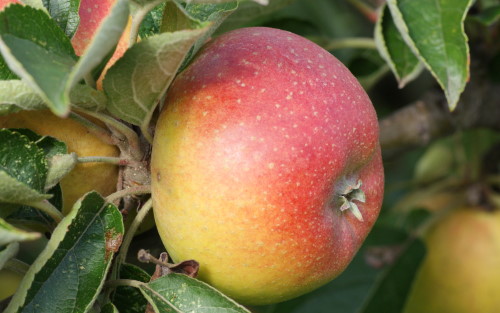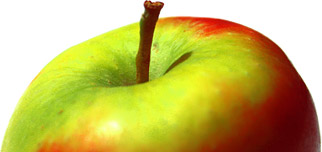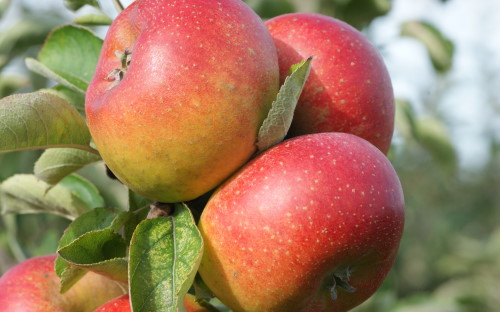
Court Pendu Plat is old apple variety from France, with a history dating
back to the early 1600s and many
earlier references. It was popular in Victorian times and still has a
small following.
With such an ancient lineage it is perhaps no surprise that Court Pendu Plat is quite different from many other varieties. The most distinctive feature is the strange flattened appearance. The base is highly inverted and you can clearly see the flower stalk from which the apple formed. The colouring is light green flushed with orange and red.
The flesh is very dense, not soft but not crisp either. Cutting into it with a knife feels a bit like cutting into a hard cheddar cheese. There seems to be very little juice, and it is not really apple-flavoured at all. The flavour is fruity and strong when picked, and sweetens by Christmas. It is not actually very appealing when you first bite into it, yet is strangely "more-ish", with a flavour which is hard to define. It can also be used for cooking.
Although we have no proof, we think Court Pendu Plat could be somewhere in the ancestry of Cox's Orange Pippin. The size, flattened shape, colouration, and complex flavours of Cox are all there in Court Pendu Plat, albeit in a more primitive form. Cox's probable parent - Ribston Pippin - was apparently grown from a seedling brought to England from France in the early 1700s, a time when Court Pendu Plat was well-established on the Continent.
With such an ancient lineage it is perhaps no surprise that Court Pendu Plat is quite different from many other varieties. The most distinctive feature is the strange flattened appearance. The base is highly inverted and you can clearly see the flower stalk from which the apple formed. The colouring is light green flushed with orange and red.
The flesh is very dense, not soft but not crisp either. Cutting into it with a knife feels a bit like cutting into a hard cheddar cheese. There seems to be very little juice, and it is not really apple-flavoured at all. The flavour is fruity and strong when picked, and sweetens by Christmas. It is not actually very appealing when you first bite into it, yet is strangely "more-ish", with a flavour which is hard to define. It can also be used for cooking.
Although we have no proof, we think Court Pendu Plat could be somewhere in the ancestry of Cox's Orange Pippin. The size, flattened shape, colouration, and complex flavours of Cox are all there in Court Pendu Plat, albeit in a more primitive form. Cox's probable parent - Ribston Pippin - was apparently grown from a seedling brought to England from France in the early 1700s, a time when Court Pendu Plat was well-established on the Continent.
Also known as
- Court Pendu Rouge
Court Pendu Plat apple identification images
All images copyright Orange Pippin unless otherwise stated.
USDA identification images for Court Pendu Plat
The identification paintings in the USDA Pomological Watercolor Collection span the years 1886 to 1942.
Citation: U.S. Department of Agriculture Pomological Watercolor Collection. Rare and Special Collections, National Agricultural Library, Beltsville, MD 20705.
Visitor reviews
- 30 Aug 2024Huge issue with this variety is it's late blooming, much later than all other varieties. Since it needs other tree for polination, it means it won't have apples in most years, unless you plant another late blooming variety.
- 26 Oct 2015 NY, United StatesDense, fragrant, wonderful flavor. Bought at a Greenmarket in New York City October 2015, in a one-week appearance. Wish I had bought more as all sources say they are wonderful keepers -- I will look for them again this time next year.
- 13 Sep 2010 CAMBRIDGESHIRE, United KingdomAlthough CPP is often quoted as being scab resistant, it is the fruit that has good resistance to scab, but the leaves are not resistant to scab. CPP also has "some resistance" to mildew and canker, but it is not immune. Late flowering can cause problems with pollination, but there are a handful of good-quality, organic-suitable, late-flowering varieties that are worth growing alongside CPP - such as Edward VII and Crawley Beauty. In my region, I find that MM106 rootstock often tends to bring varieties into flower slightly earlier (one pollination group earlier) than the other rootstocks, which could allow clever rootstock selection to slightly bring forward the flowering time of CPP. Additionally, if planting more than one tree, if the CPP is planted in the sunnier spot and the other tree in the shadier spot, you may also bring closer their *relative* flowering times by one pollination group as a result of the CPP warming up more quickly in the spring. The very-slow-growing nature of CPP leads me to suggest a somewhat stronger rootstock than you'd normally consider. In a collection of trees I'd suggest that CPP has a size larger rootstock (e.g. MM106 if planted with "average-vigour" M26 trees) to allow the CPP keep up with the growth rate of its companions.
- 16 Jun 2010 WASHINGTON, United StatesThis variety looks interesting: scab resistant; strong unusual flavor, long keeper, Heritage! Anyone in Canada or the States who have it care to say how it is performing for you? Late bloom can be a plus in Spokane. Last frost is often in early May, this year was 24th May 2010.
- 08 Jun 2009 SOMERSET, United KingdomWe've grown this variety for a number of years. Ours are much more russeted than the one in your picture, and reddish golden brown when ripe, certainly not pale green! They are small, and very flatttened, and the late flowering means that pollination is a problem in many seasons. However they are delicious when ripe, which is rarely before Christmas. They are sweet, spicy and aromatic. The flesh is slightly dry like many russets.
- 05 Feb 2009 NORTH YORKSHIRE, United KingdomHazel, There are very few varieties that can truly be said to be pre 17th century. Derek at Bernewode Plants has done a great deal of research into the early varieties and he is your best bet to source them. Those that come immediately to mind are Nonpareil and White Joaneting as well as CPP. 17th Century apples are a little more identifiable. The best original source is John Worlidge, who wrote in the late 1600's, particularly his Vinetum Britanicum (1678, 2nd Ed). He specifically names Margaret (available from Brogdale), Devonshire Quarendon (Keepers Nursery, et al), Genet Moyle and Catshead - all of which can be sourced quite easily. The great Ribston Pippin was also planted in 1688 (Rogers of Pickering). Any or all would do very well in Bristol. It is also claimed that the greatest 17th Century apple, the Redstreak, has also been rediscovered (Brogdale, Matthews) although it remains to be seen if this can really be said to be the apple of our ancestors.
- 26 Dec 2008 BRISTOL UK, United KingdomI want to buy a pre 17th c variety of apple if I can for my garden in Bristol... have you any advice on / pictures of the tree growing I can see.. where did you get yours ?? thanks hazel.
- 02 Nov 2008 PLOX GREEN, SHROPSHIRE, United KingdomI have had an excellent crop of these apples this year, and have just started to pick them (02/11/08, after first frost). Mine are flatter and matter, like Jim's of Wakefield. The longer I have left them on the tree, the more yellow some have become - it has not been the sunniest Summer or Autumn. I was delighted to read that they are going to continue to improve in eating between now and the Spring as I found them rather hard on picking.
- 01 Oct 2008 WAKEFIELD, United KingdomThe photograph you have does not look much like the fruit I get from the tree I grow as Court Pendu Platt. My fruit are flatter, and the green base colour is more matt with deeper matt red colouring. CPP flowers very very late, often when no other apples are flowering, so pollination can be a problem.
- 08 Feb 2008 BRISTOL, United KingdomPeter Wellbery Smith grows this just south of the Wash near King's Lynn. He says March is the best month for eating. The ones i have in front of me from him (8/02/08) are already good. Discreet but deep in flavour, spiced and hard and utterly toothsome.
Tree register
United States
- Albany Appleguy in Castleton, NY
- Alex in Freeland, WA
- Axel Kratel in Santa Cruz, CALIFORNIA
- Brian Van Erem in Green Bay, WI
- Florian Deisenhofer in Brush Prairie, WA
- Mike Haller in SIOUX CITY, IOWA
- Milovan Popovic in Ellington, CONNECTICUT
- Nathan Parker in Mount Shasta, CA
- Noah McVay in Spring Green, WISCONSIN
- Ryan Parsell in Langley, WA
- Stephen Mynhier in Fort Mill, SC
- Stephen Sain in Los Lunas, NEW MEXICO
- Stewart in American Fork, UT
- Tracy in Ravensdale, WA
- Whitney Peters in Sixes, OREGON
United Kingdom
- Andrew Jones in York, UK
- Andy Davice in Oxford, OXFORDSHIRE
- Bill Barker And Sharon Cherry in Smeeton Westerby, LEICESTERSHIRE
- Bobthomlinson in Whaley Bridge, DERBYSHIRE
- Craig Bridge in Lincoln, LINCOLNSHIRE
- David Hill in Braintree, ESSEX
- Diana Gibbs in LOWER RAYDON,
- Donna Gillies in Ardgay, HIGHLAND
- Dr Dennis Bancroft in Near Rugby, NORTHAMPTONSHIRE
- Eileen Brown in Blairgowrie, PERTH AND KINROSS
- Gabrielle in EDINBURGH,
- Henry in NEWARK, NOTTINGHAMSHIRE
- Jean Lippett in Martock, SOMERSET
- Kevinincornwall in Liskeard, UNITED KINGDOM
- Lenore Greensides in Beverley, EAST YORKS
- Linda Semple in West Kilbride, NORTH AYRSHIRE
- Lindy Brett in MACCLESFIELD, CHESHIRE
- Mariska Van Loenen in Aberdeen, ABERDEENSHIRE
- Mike Coote in Chichester, WEST SUSSEX
- Mr m Buckler in MATLOCK, DERBYSHIRE
- N. Buck in
- N. Buck in Cambridge, CAMBRIDGESHIRE
- N. Buck in Cambridge, CAMBRIDGESHIRE
- N. Buck in Cambridge, CAMBRIDGESHIRE
- Nick Burrows in Helmsley, NORTH YORKSHIRE
- Nigel in CAMBRIDGE, CAMBRIDGESHIRE
- Peter Barnard in Doncaster, LINCOLNSHIRE
- Peter Revell in Hemel Hempstead, HERTS
- Sedgie in SALTBURN BY THE SEA, NORTH YORKSHIRE
- Simon Wilkins in Bradford, WEST YORKSHIRE
- Steve Sim in Grange Over Sands, CUMBRIA
- Tony in Glasgow, SCOTLAND
- Yaron Peled in Pelynt, Looe, CORNWALL
Ireland
- Lars Christoffersen in TRIM,
Netherlands
- Bert Schudde in Westeremden,
Canada
- Bill O'Keefe in Dobbinton, ONTARIO
- David Maxwell in Middle Lahave, NOVA SCOTIA
Australia
- a Bear in TOOLANGI, VIC
- Fletcher Farrington in Warragul, VICTORIA
- Paul Huckett in Numurkah, VICTORIA
- Stephen Boardman in Acton Park, TAS
Switzerland
- Veronique Ascheri in Anieres, GENEVA
Spring blossom records for this variety
2018 season
- 15th May 2018 - tree owned by Bill in Smeeton Westerby, United Kingdom
2017 season
- 16th May 2017 - tree owned by Bill in Smeeton Westerby, United Kingdom
2016 season
- 3rd June 2016 - tree owned by Bill in Smeeton Westerby, United Kingdom
2015 season
- 28th May 2015 - tree owned by Bill in Smeeton Westerby, United Kingdom
2014 season
- 23rd May 2014 - tree owned by Bill in Smeeton Westerby, United Kingdom
2013 season
- 4th June 2013 - tree owned by Bill in Smeeton Westerby, United Kingdom
2012 season
- 4th June 2012 - tree owned by Jean in Martock, United Kingdom
- 26th May 2012 - tree owned by Lenore in Beverley, United Kingdom
2009 season
- 11th May 2009 - tree owned by N. in Cambridge, United Kingdom
- 11th May 2009 - tree owned by N. in Cambridge, United Kingdom
Record your blossom dates in our Fruit Tree Register - more >>.
Harvest records for this variety
2017 season
- 1st week October 2017 - tree owned by Bill in Smeeton Westerby, United Kingdom
2016 season
- 3rd week October 2016 - tree owned by Bill in Smeeton Westerby, United Kingdom
2015 season
- 4th week October 2015 - tree owned by Bill in Smeeton Westerby, United Kingdom
2014 season
- 1st week October 2014 - tree owned by Bill in Smeeton Westerby, United Kingdom
2013 season
- 3rd week October 2013 - tree owned by Bill in Smeeton Westerby, United Kingdom
2012 season
- 4th week October 2012 - tree owned by Jean in Martock, United Kingdom
2009 season
Origins
- Species: Malus domestica - Apple
- Parentage: Unknown, extremely old
- Originates from: France
- Introduced: 1613
- UK National Fruit Collection accession: 1948-328
Identification
- Country of origin: France
- Period of origin: 1600 - 1649
- Fruit colour: Orange flush
- Leaf colour: Green
- Popularity: Rarely grown
- Annual cycle: Deciduous
Using
- Picking season: Late
- Keeping (of fruit): 1-2 months
- Flavour quality: Very good
- Flavour style (apples): Aromatic
- Discoloration of fruit: Very oxidising (browns quickly)
- Cropping: Good
- Fruit persistence: Normal ripening
- Food uses: Eating fresh
- Food uses: Juice
- Picking period: mid-October
- Wildlife: RHS Plants for Pollinators
Growing
- Gardening skill: Average
- Flowering group: 6
- Pollinating others: Average
- Ploidy: Diploid
- Vigour: Average vigour
- Bearing regularity: Regular
- Fruit bearing: Partial tip-bearer
- Attractive features: Attractive flowers
- Self-fertility: Not self-fertile
Climate
- Frost resistance of blossom: Good resistance
- Cold hardiness (USDA): Zone 4 (-34C)
- Climate suitability: Temperate climates
- Summer average maximum temperatures: Cool ( 20-24C / 68-75F)
- Summer average maximum temperatures: Warm (25-30C / 76-85F)
Other qualities
- Disease resistance: Good
- Scab (Apple and Pear): Very resistant
- Powdery mildew: Very resistant
Where to buy trees
The following tree nurseries offer Court Pendu Plat apple trees for sale:
- Orange Pippin Fruit Trees (USA) United States
Court Pendu Plat apple trees - Orange Pippin Fruit Trees (UK) United Kingdom
Court Pendu Plat apple trees - Thomas Fruit Trees (EU) France
Court Pendu Rouge apple trees - Cummins Nursery
United States More >>
Where to buy fresh fruit
The following orchards grow Court Pendu Plat:
United States
Maine
- Tiny Orchards, Saco
Michigan
- Alber's Orchard & Cider Mill, Manchester
United Kingdom
England - north
- Coulton Mill, York
England - south-west
- Charlton Orchards, Taunton
Canada
British Columbia
- Salt Spring Apple Company, Salt Spring Island
Australia
Victoria
- Heritage Fruits Society, Fairfield
References
- Apples of England (1948)
Author: Taylor - Some Antique Apples for Modern Orchards, (2008)
Author: Merwin I.A.


